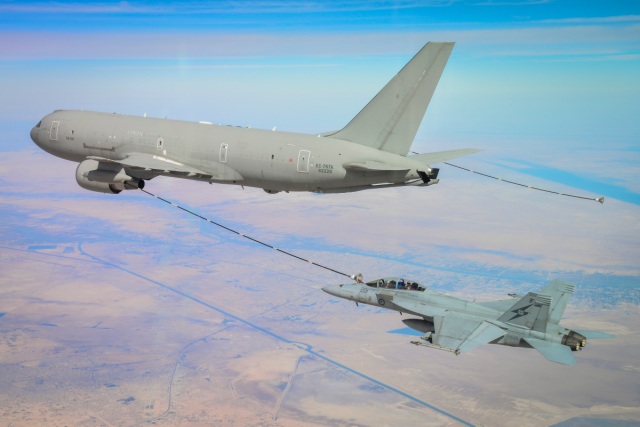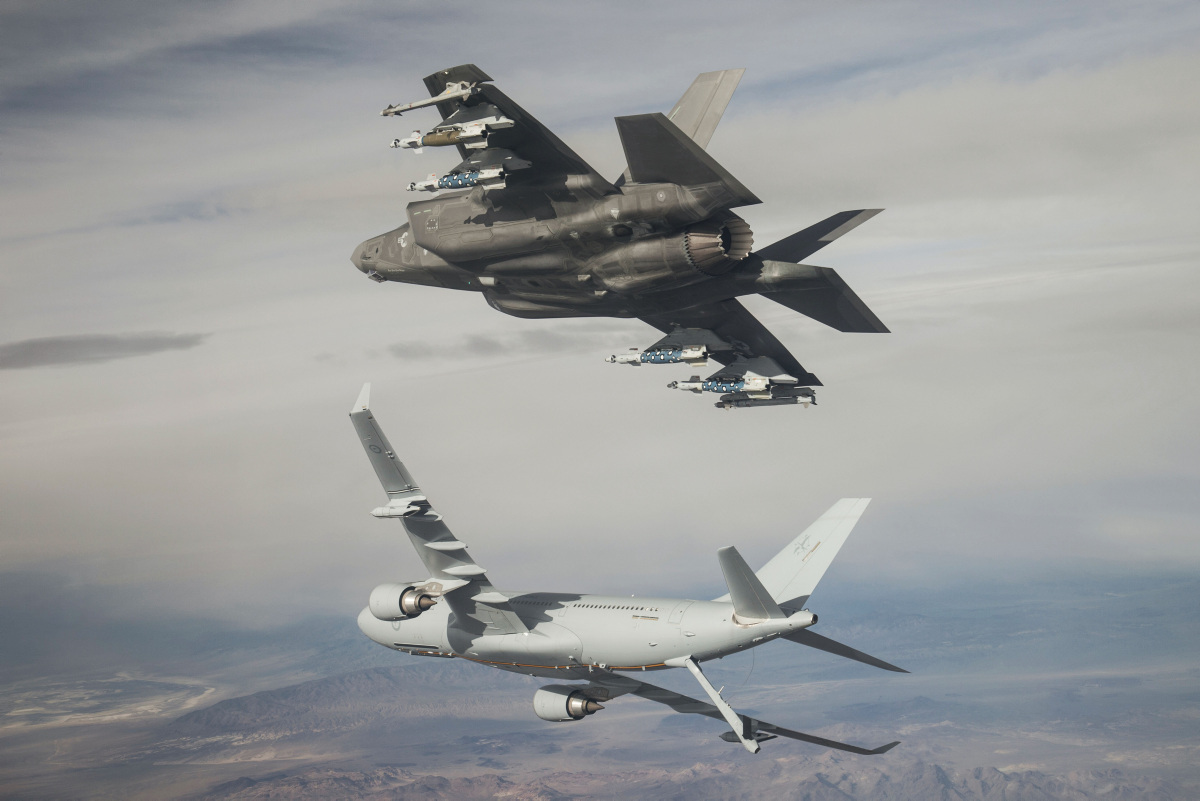By David Beaumont.
Our friends at The Central Blue and From Balloons to Drones are currently engaged in a comprehensive look at airpower in high-intensity warfare. Logistics will undoubtedly feature in the #highintensitywar series, as a major driver of preparedness, combat potential and power, and operational endurance. Technology and ‘5th-generation’ airpower may have demonstrably changed the way in which air forces will fight, but the properly applied sustainment practices which have served them well in the past will continue to do so in the future. These practices will offer both options and constraints to operational planners, and the effectiveness of supply chains delivering fuel, ammunition and spare parts will fundamentally determine the duration of air operations. None of this is particularly revelatory, even to the facile commander who stubbornly ignores that warfare is about practicalities. However, it is also important to the appreciation of high-intensity warfare to look at how the resiliency of logistics lights the way to operational success.
In one of the earliest posts on Logistics in War, I argued that ‘[l]ogistics has emerged from a decade-long hiatus to reassert its relevance’. As the US military, NATO and others responded to shifting strategic circumstances and re-postured their forces against imagined (and what seem to be increasingly realised) threats, new logistics systems were being established. Exercises undertaken to simulate high-intensity war such as US Pacific Command’s Exercise Pacific Sentry 17-03 highlighted significant force posture challenges that might constrain air (and other) operations against a peer adversary. Similarly, other problems which may affect the capacity for militaries to respond quickly in an environment of high-intensity warfare were eloquently shared by Jobie Turner in a series of Logistics in War articles. The propensity of adversaries to target logistics capability in these scenarios was also raised. Militaries certainly seemed aware of major logistics challenges to preparing for peer-to-peer conflict in high-intensity warfare, and were adapting as rapid as they could.
There seems a multitude of ways in which logistics will influence future warfare, either directly or indirectly. This post serves as a reminder of one of these ways – a general feature known as the ‘logistics vacuum’ – initially described in Fighting in the void – combat operations in the logistics vacuum. This feature appears because of the tendency to gloss over the logistics consequences of battle, and the inevitable drop in logistics capacity and capability that emerges with fighting. Appreciating the ‘vacuum’ is the first step towards preparing for it. With this in mind, what follows is an adaption (and in some places a repetition) of what was articulated some time ago, with elaboration as it may apply to high-intensity warfare in the air domain.
As force posture changes or as combat is prepared for, sustainment methods for combat forces often become optimised for specific and often localised conditions. Prepared forces are so because they have robust, and as efficient as practicably possible, logistics systems that are capable of sustaining them for extended periods of time. Except in cases of extreme strategic surprise, logistics might appear relatively unimportant to the well-prepared force at the outset of combat. Resources are presumably plentiful, and firepower is assured, especially for those air forces defending their own territory. Unfortunately, and it is a general rule of war, this rapidly changes as combat begins and the system of sustainment adjusts.

A RAAF KC30 refuels an F/A18 on Operation Okra, above Iraq. Photo by Department of Defence.
When combat commences robust logistic systems allow for a high intensity of engagement – at least initially. However, this changes quickly soon after the first shots are fired, usually because logistics forces, bases and those capabilities from which a force derives its strength are targeted. Forces would soon exhaust ammunition if the rate of effort demanded it, materiel used inefficiently as necessity breeds invention, health care inevitably overwhelmed and the distribution capabilities supporting operational supply chains are overstretched. Air mobility will prove unable to respond rapidly enough for all sustainment requirements and compromises will have to be made. The loss of air-to-air refuelling platforms might pale in significance to the difficulties encountered on the ground as bulk fuel installations are targeted or demand for fuels outstrips its supply. When logistic support in other quarters fails to materialise the adversarial combat forces would be forced to adapt their tactical activities and the intensity of warfare would decrease commensurately. Combat becomes attritional, and the fight for logistics becomes as important as the fight for survival. In such circumstances the flexibility of and logistics forces remaining after the initial firefight becomes crucial to recovering any aspect of the initiative, and restoring tempo to the operation.
Vladimir Prebelic described this phenomenon as the ‘logistic vacuum’.[i] He saw it as a general feature of war because logistics elements and systems are typically and extensively targeted by adversaries, particularly as their initial targets, so make the opposition incapable of a substantial response. Instigating the ‘logistics vacuum’ in the offense, against a peer threat, is exceptionally difficult as the defence offers natural advantages including access to supply, let alone protective capabilities to interdict a threat. In a briefing on the developing F-35 capability in a high-intensity engagement in the Pacific, RAND commentators paint a picture of immense difficulty in achieving offensive strike effects against a potential adversary’s infrastructure. Nonetheless, there are many ways in which logistics in depth can be attacked from air combat forces to ‘anti-access, area-denial’ missiles used in the maritime domain, to rocket-based artillery that can target key logistics infrastructure at tremendous ranges. In a multi-domain environment, the threat to the logistics capabilities sustaining air operations can come from any quarter.
Further problems may be entirely self-induced, or the result of formerly efficient supply chains collapsing as hostile forces prevent the easy replenishment of combat forces. One wonders how resilient high-technology forces, as air forces are, may be to supply chain disruptions as strategic sources of supply suffer in wars against major powers – those that are likely to be the only powers able to engage Western militaries in high-intensity war. The natural uncertainty that exists in war, especially high-intensity warfare where destruction can be rapid, and the impact of capacity constraints introduced by the desire to deploy with a light logistic ‘tail’, also conspire to create logistic shortcomings that magnify the effects of the adversary’s attacks. The problem is particularly significant for operational and tactical-level logistics organisations who must establish in-theatre logistics infrastructure while under fire; a key concern for the deployment of expeditionary base capabilities and other support required to maintain combat operations.
The ability of logisticians and commanders to overcome the effects of the ‘first strike’ by working a logistic system out of the remnants of what existed in peacetime will often determine the operational initiative. Winning a defensive battle is the obvious way to preserve logistics capacity and allows for a rapid restoration of tempo. Options proposed include defensive measures such in the rear of the operational area, the reinforcement of logistics elements, platforms and bases with self-protection capabilities such as anti-air systems, protection of logistics infrastructure via the establishment of operating bases, and through distance and dispersal. Such measures are essential to providing resiliency to the logistic system that, if attacked, will prevent a catastrophic collapse of support. However, these measures are also only part of the problem. Reassessing doctrine, training and thinking to respond to the inevitable logistics vacuum will be fundamental to the logistician and commander in their mental preparations for war.
Nonetheless, the ‘logistic vacuum’ is an oft-repeated feature of warfare, and military thinkers have yet to conceptualise a way out of it. What really matter is that military planners design forces and logistics capabilities that are able to reduce the time it takes for the combat force to emerge from the ‘vacuum’, and with the initiative. All attention should be given to the ways in which risks can be reduced, the resiliency of the logistic system improved and flexibility of logistics forces enhanced. The perfect solution would be to provide logistic support in an over-abundance, particularly to those that must deploy forward, but that isn’t a realistic expectation to have. Forces must be prepared to operate austerely, logisticians better empowered to prioritise resources, and all must plan and rehearse accordingly.However, we shouldn’t be overconfident in our attempts to avoid the inevitable.
As we think about high-intensity warfighting in the air domain, or any other area, it is worth remembering that the quality of logistics support that may be expected at the outset of combat will undoubtedly drop. It is for this reason that this article serves as a reminder of a key phenomenon of logistics in conflict – the ‘logistics vacuum’. As I concluded in 2017, combat forces shouldn’t have a misplaced faith that they would be able to operate with everything they need, nor should any logisticians make claims as to be able to offer a solution that prevents a capitulation in logistics support. The best both can do is be adaptable.
[i] Prebelic, V., ‘ Theoretical aspects of military logistics’ from Defence and security analysis, Vol. 22, No. 2, Routledge, USA, 2006. Sorry – another paywall!

Great read, but the pic shows an Italian KC-767 refuelling the Super Hornet, not a KC-30.
LikeLike